Play Strategy: Play Out of Hours!
A toolkit for the use of school grounds for playing out of teaching hours.
Part 2:
Tools to assist
This part of the toolkit has been prepared to support the school community to consider ways in which it can provide time, space and permission to promote freely chosen play for children in their own school grounds out of teaching hours. This approach may feel like a departure from current day-to-day work. However, the following question will provide a useful starting point – “When I was younger where were my favourite places to play and spend time with my friends?”
Experience tends to show that these were not expensive, adult-led places, but outdoor places where as children we made our own fun and had our own adventures. Schools can play a part in recreating these environments within the school grounds.
Section 2.1
School play policy
Adopting a school play policy will make a significant contribution to providing a rich play environment for children. A school play policy states the value that the school places on children’s play and commits itself to supporting children’s play opportunities. The policy can be shared with the children, staff and parents and be included in the school prospectus. A school play policy should demonstrate how play contributes to other national and local policy documents.
School play policy template
This school recognises the importance of all the children who attend having sufficient time and good places to play freely as part of their day.
To children, playing is one of the most important aspects of their lives. Playing contributes to children’s health, well- being and happiness as well as to their learning and their ability to learn. Most importantly playing contributes to children’s ability to thrive and survive. Some children only have the opportunity to play with their friends at school.
A very positive contribution can be made to children’s lives by valuing their urge and desire to play and providing for a broad range of play opportunities within the school playgrounds before, during and after the school day.
This school recognises that children will naturally create and/or seek out challenging situations; while making the most of their play some children may have accidents, get dirty or wet or upset. We recognise that any potential risk of harm to children needs to be balanced with the potential for good that may come from their taking part in a particular form of play. We will do our best to avoid children coming to serious physical or emotional harm by carefully managing the play opportunities that we provide.
This school believes that adults’ attitude towards, and understanding of, children’s play behaviour will have a significant effect on the quality of the play opportunities offered within and outside the school. This school will therefore seek out training opportunities and support research among its staff so that they are confident to facilitate children’s freely chosen, self-directed play.
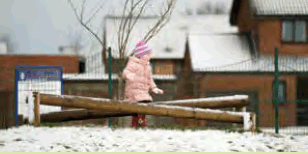
Section 2.2
Undertaking an options analysis
The use of an options analysis template can help schools to determine the best decision, model and approach to take with regards to making school grounds available for play out of teaching hours.
The advantages and disadvantages for each option can be listed – scoring 1 point for each advantage and -1 for every disadvantage.
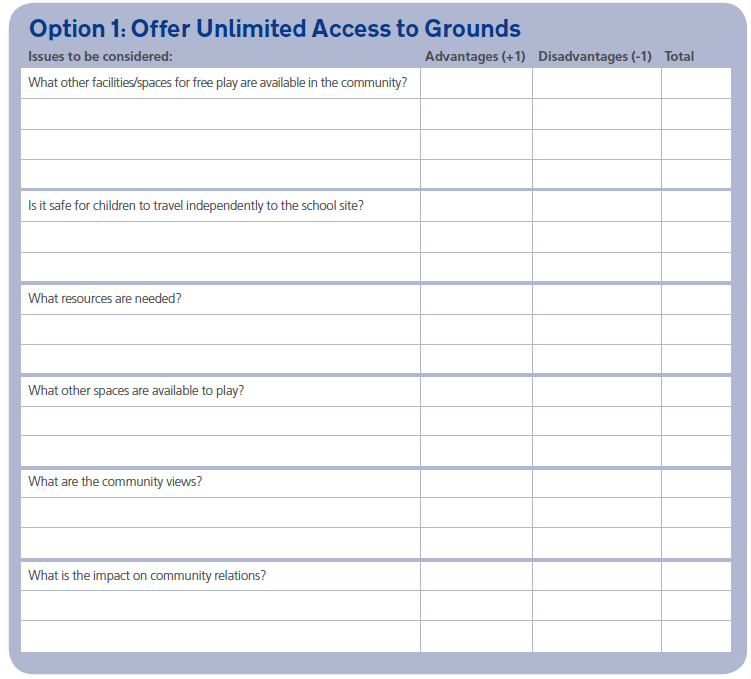
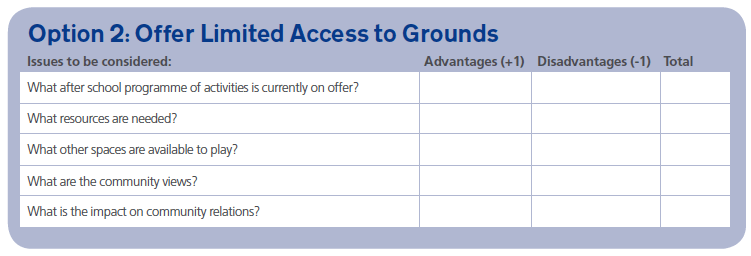
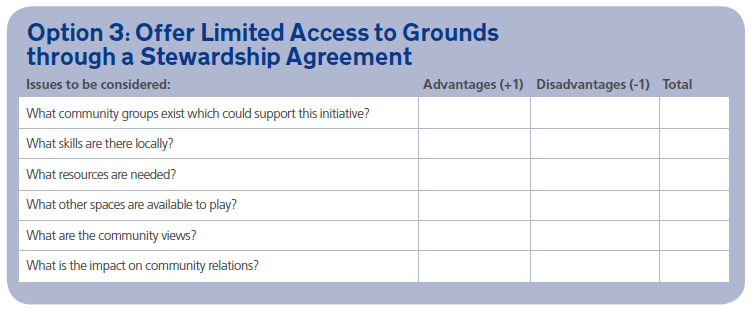

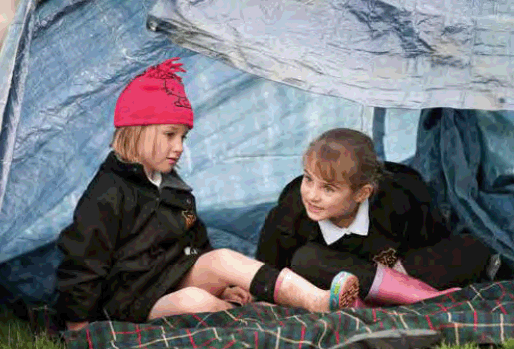
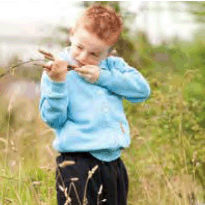
Section 2.3
Engaging with children
In the same way that schools have appointed sports champions or curriculum specialists, a ‘play champion’ could take responsibility for ensuring the school considers the play needs of its pupils.
The first people to talk to are the children. Pupil Councils may provide the mechanism for this but it is important to involve the whole school. The children can help:
- Undertake an audit of how, and more importantly which, parts of the school grounds are already being used; before school, at playtime, break times, lunchtime, and after school. The children are best placed to identify the potential for play.
- Identify where else children and young people are spending their time in the local community off the school site and what they do there – this will help to plan priorities.
- Identify the routes children and young people use to get to and from school and what method of transport they use.
- Identify the barriers that might prevent greater use of the grounds out of teaching hours, such as roads and water courses and also perceived community boundaries, cultural and ethnic divides.
The Questions and notes for facilitators template on the next pages can be used to engage with children.
Questions and notes for facilitators template
According to the United Nations Convention on the Rights of the Child (UNCRC) you have the right to say what you think should happen when adults are making decisions that affect you. These questions are to help us find out what you think about the places where you play or spend time with your friends near where you live when you are not in school.
The sample answers are not exhaustive and facilitators can encourage more extensive responses.
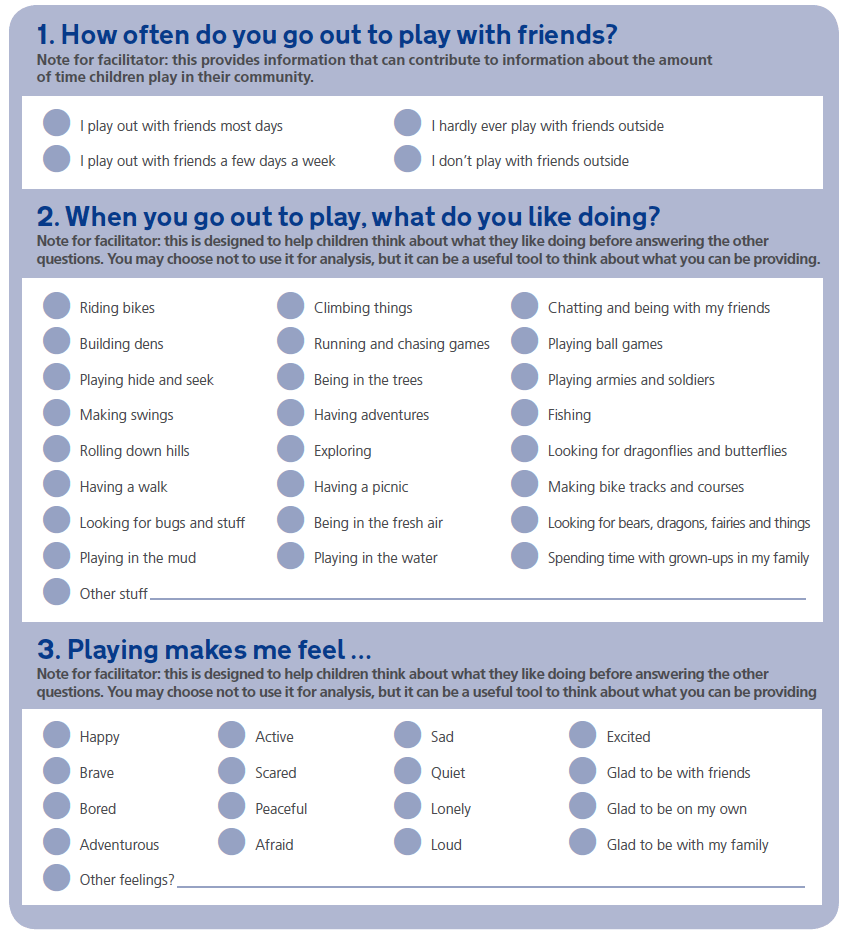
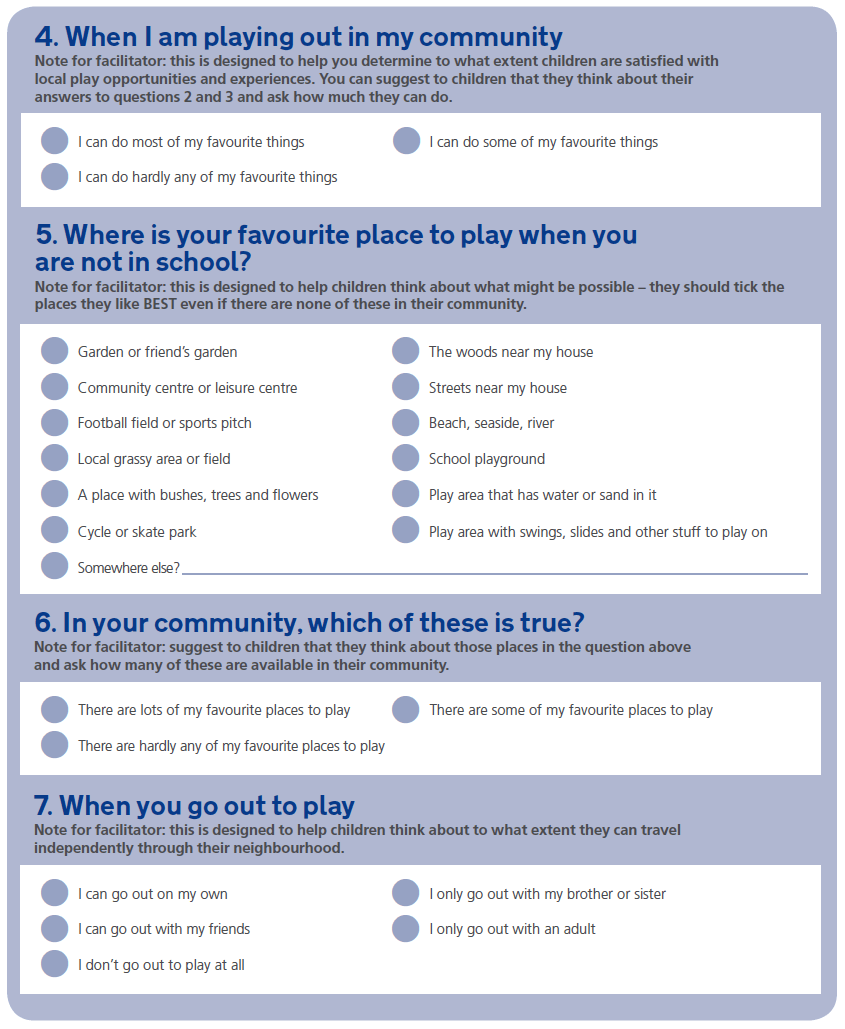
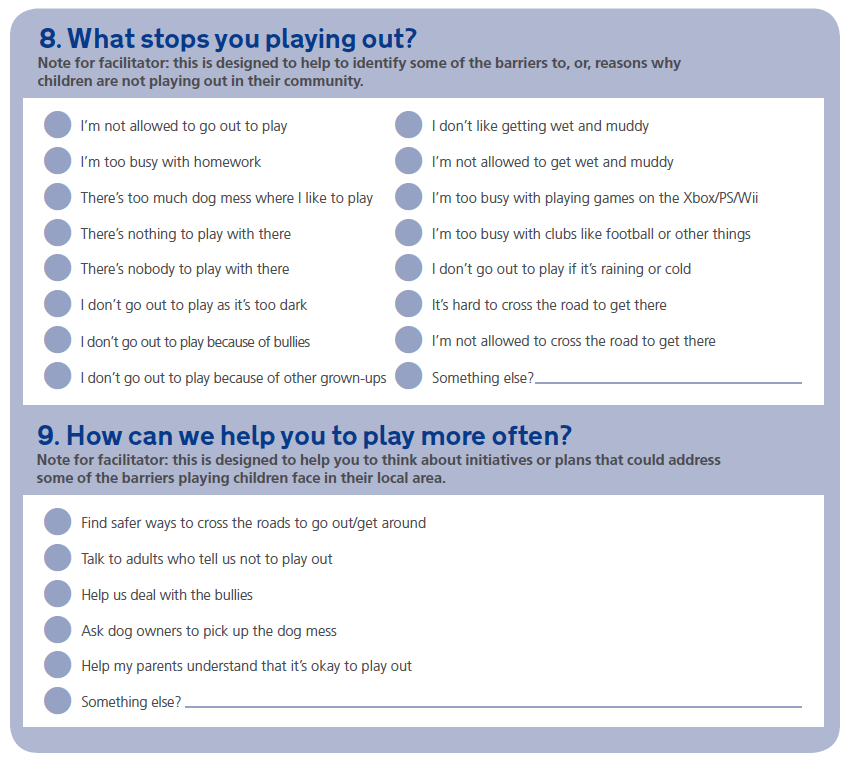
Section 2.4
Play audits
To understand what could be offered, it is important to consider the local community and environment in which children live. Given time, space and permission to play, children will naturally choose to play wherever and whenever they wish. Once what is available to children is known, it can be assessed against how children need to play. Play audits provide a process to measure effectively if children’s play needs are being met within a community.
Adults as auditors
Schools will already have a good range of information about the geography, demography and culture of the community. Gathering information about other provision, such as scouts, will help to inform decisions about what is offered.
Monitoring how the school grounds are used during teaching hours will help to identify their potential for play. For instance questions that might be considered include:
- What happens before school starts and during play/break time?
- What do children gravitate towards?
- What parts of the grounds do children first occupy and what spaces do they avoid?
The use of, or lack of space and resources can be observed and recorded. An area that isn’t used much might benefit from sensory enhancement, an injection of colour or loose parts to more actively promote to children that this is a place where they can play.
The layout of a site, where things are, and how children have modified spaces and have moved things around, are all clues to children’s need to play and individual preferences.
Regular observation of children can become a routine enabling the capture of children’s natural play behaviour. Using a notepad, phone, voice memo and camera can all be useful methods for capturing the moment and need not be intrusive. The need to gather information should never significantly interfere with children’s right to play. As well as planning when and where observations are undertaken, if the tools for observation are readily available, it is possible to capture and record events as they happen.
Whatever method is used for observations the following information should be recorded:
- What is being observed and why. For example, watching how children use a particularly popular piece of equipment to find out why
- The date
- The time
- The place
- A record of what is actually happening (not what we imagine is happening)
- A record of what is being said and by whom.
After the event it is valuable to reflect upon what has been observed, to begin to interpret what has been seen, and what it means in terms of the audit.
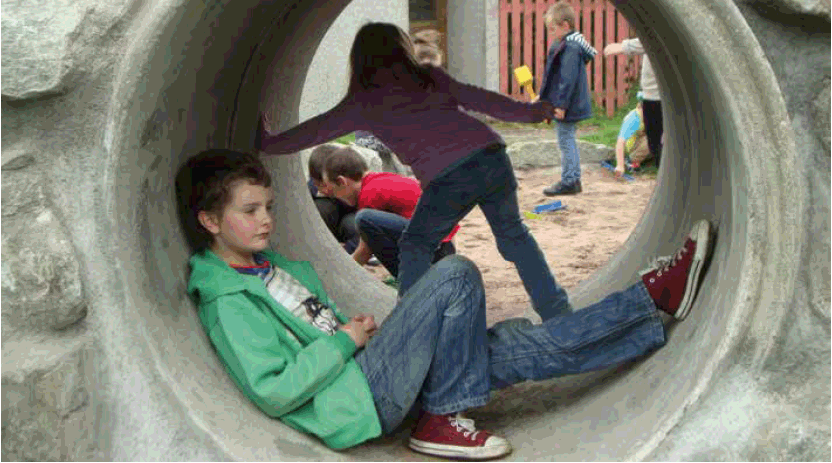
Children as auditors
A child at play will naturally and instinctively interpret a space and make changes to it, or else simply move on because the space doesn’t offer, or has ceased to offer, what they need. For those responsible for auditing play spaces, the most reliable source of information will be the children. When auditing a play space it is important to remember that this is an adult activity and not children’s. It is important not to infringe on children’s time, but if they are to feel the play setting belongs to them, their participation is beneficial in supporting a sense of ownership.
Some children simply enjoy having a role to play. Their natural curiosity will cause them to ask what is being done when they see adults counting resources and they may want to help. Without duress and with some guidance there are a number of ways children can inform the audit of the play space.
Looking at maps with children can be a good way to look at the geography of an area and begin to understand how children are playing within it.
Other methods that include children:
- Drawing pictures of what they like to do
- Interviewing other children about their interests
- Producing and completing questionnaires with their peers
- Taking photos of what’s happening in the play space
Going out into the community, sensitively observing children playing and chatting to them will also help gather information from children.
It is important to remember that with any children’s involvement with auditing they do not feel they are being promised something that can’t be delivered. Asking children a range of questions and encouraging participation will help children see the possibilities. This is a mapping stage that also involves interpretation of the space and what happens within it to support decision-making processes.
If at any point through the process mixed messages are conveyed, over the future development of the setting or resources, children will feel disengaged and their sense of ownership damaged. Children across different stages of understanding will interpret things varyingly, so keeping participation developmentally appropriate will help reduce the risk of misunderstandings happening.
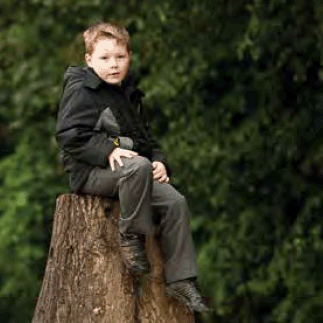
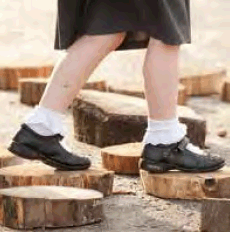
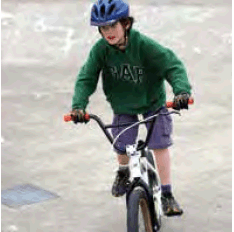
Section 2.5
Identifying the potential for a space to promote play
Play space audit checklist
A play space audit is a valuable tool to use when identifying the potential for playing. If children already use the space for playing, there will be evidence of this. The Play space audit template is designed to help identify where children are playing, what they are doing and how often they use the space for playing. It should be noted that apparent signs of neglect such as litter, broken branches on trees and graffiti are, in fact, often signs of positive use by children.
A play space audit also helps in other ways. Firstly, it forms part of the participation and engagement process and can help the gathering of evidence to support what the community and children are saying. Secondly, conducted at regular intervals (for example six monthly) it can be used to help monitor how the space is being used and how often.
How to conduct a play space audit
The Play space audit template on the following pages is intended for an observation that should take a minimum of 30 minutes. Ideally, this should be undertaken during different times of the day to see how different age groups use the space. For example, undertake an observation at the weekend or after school and another one during the day to observe pre-schoolers using the site with their parents or carers. Choosing when to undertake observations will depend on the site.
There are a number of play behaviours that are described in more detail below to help with the observation. There will be play behaviours that can be identified without needing to see children playing. For example, if children gather and meet on boulders or seated areas, there will be signs of wear from scuffing feet or holes dug with toes or sticks.
If the space is an appealing place for children it is likely there are a number of factors that contribute to this. Children say that issues such as how well lit the space is, how close it is to homes, and whether or not there are places to shelter contribute to a sense of feeling safe and appeal to a broad age range. If this is the case the space will need to be designed in a way that provides for that wide age range and provides for a changing demographic.
All children have different play needs and wishes that can change with time. Separating people into age and other groups is not necessarily beneficial (although some may need particular support to meet their own needs). Interaction between all age groups and members of society is a vital process that supports all children and young people to feel more confident about playing out. Building relationships with other children and young people gives an opportunity to share knowledge of the people and geography of neighbourhoods and to share lore. For example, traditions of playing, rules of games, places for play such as an old lamppost which has been used for generations as the base when playing games such as hide and seek or What’s the time Mr Wolf?
Things to look out for
Walking and travelling through space
If there is a pathway running through the space it may be that children play as they move through it even if they aren't intending to stop. Behaviours can include jumping off kerbs on bikes or scooters, swinging off trees, jumping over things, running down a bank, free running/parcour. Actions which change the way children travel through the space, such as re-routing a pathway, can be considered as they may encourage better or more play opportunities.
Sitting and gathering
Even without formal seating areas there will be places where children choose to gather; evidenced by signs of wear on the ground near seating areas, under climbing frames, at the base of trees/boulders or items brought in to the space such as pieces of carpet, crates or buckets that could be used as chairs. Where there are no current obvious opportunities for formal seating areas, or gathering places, creating these will help to make the space a more social place that can be used by a wide range of ages - from families with younger children to older children gathering and chatting with their friends. Seating should be placed in circles, U or L shapes to encourage social play - placing benches in a line does not reflect how people like to gather and socialise.
Riding (bikes, scooters, skateboards)
Children's use of bikes in the space can be observed whether they are used as transport to the space or being ridden in and around the site. What features are being used to ride down, jump, skid on? Is there evidence of construction by children - such as mud ramps and timber and any improvements that have been made to support wheeled play opportunities in an informal way?
Use of natural features (e.g. trees, bushes, mounds, hills)
Use of existing natural features should be considered. Informal access points into wooded areas, and signs of litter or items brought in to the space under trees/bushes could show den building activity or secret spaces. Wear on bark or bases of trees and broken limbs on trees show evidence of children climbing trees, as do planks of wood, rope and fabric up in the trees.
Playing with the elements
Evidence of children having access to a range of natural elements to play should be considered. Children have a fascination with the natural world and should have the opportunity to experience water, earth (mud), fire and air. The grounds should be considered for access to any or all of these. It is important that these elements can be incorporated using a sensible risk management approach.
Use of the senses (taste, smell, sight, sound, texture)
Children moving through the space can be observed. Rusting leaves, sand, touching bark, feeling cold metal, rolling in grass, playing with shadows all provide opportunities for sensory play.
Movement
Evidence of how children move when they are in the space should be considered. There should be a range of opportunities to move in different ways in the play space, for example running, jumping, climbing, balancing, rolling, swinging, sliding, dancing and chasing.
Rough and tumble
Children learn about their own physical limitations, strength, controlling anger and boundaries through rough and tumble. This can come in many forms including play fighting, cops and robbers, chasing, and hide and seek. It will be clear from laughter, smiles and other facial expressions that this is a game and the children are treating it as such.
Risk and challenge (physical)
Are children experiencing increasing levels of challenge? This doesn't need to be high risk activity, it can be as simple as a young child building up from jumping off the bottom rung of a ladder to the second and then the third. Where there are opportunities for children to take physical risks they will generally look for ways to improve and increase the challenge. For example, a bike ramp made of bricks and planks of wood will soon have more bricks added as children's confidence grows.
Playing with props/loose parts
Evidence of children bringing props in from outside to enhance their play may be seen; this could be rope for a swing or wood for a den, toy cars to build a road in the mud or using natural elements such as stones, flowers, leaves, berries to build small worlds, potions or simply to create a pile or sort and categorise items.
Playing with identity
Children will play with who they are and what they look like. This could be role play games, such as mummy and baby, doctors and nurses, soldiers, power rangers or changing how they look with mud on their faces, dressing up games or pulling faces.
Play space audit template
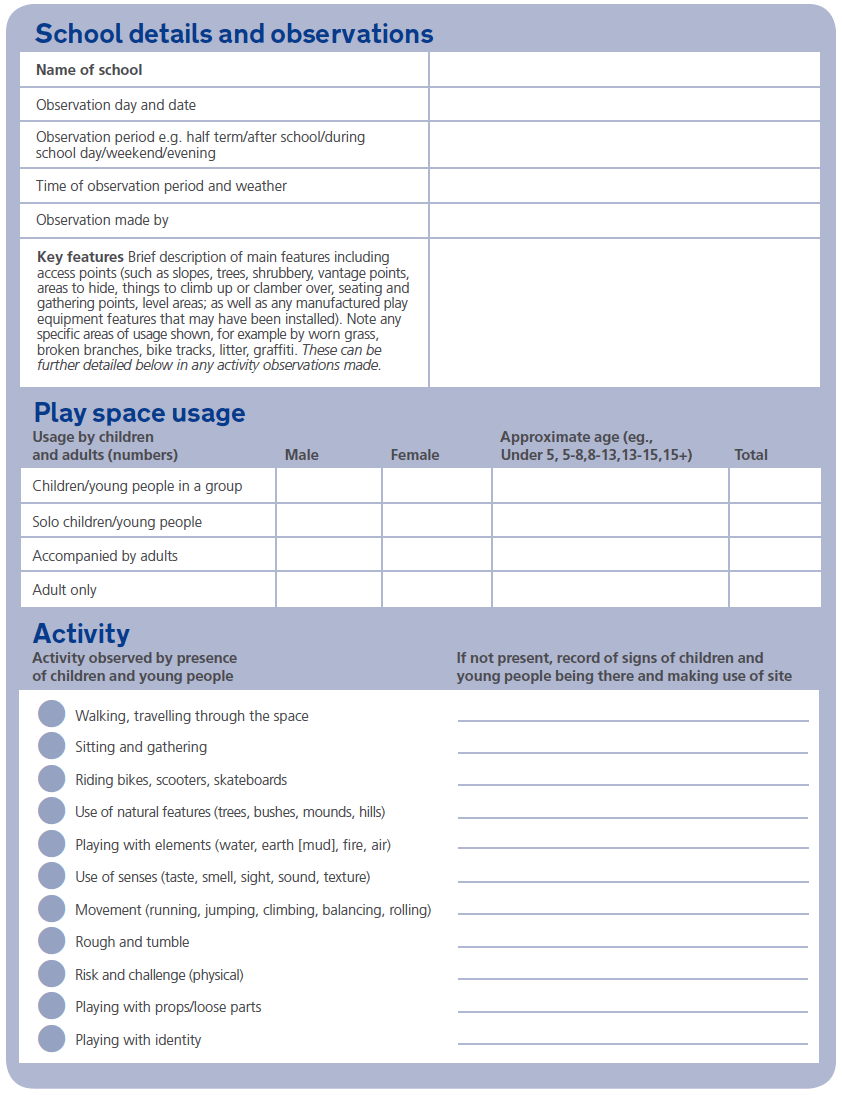
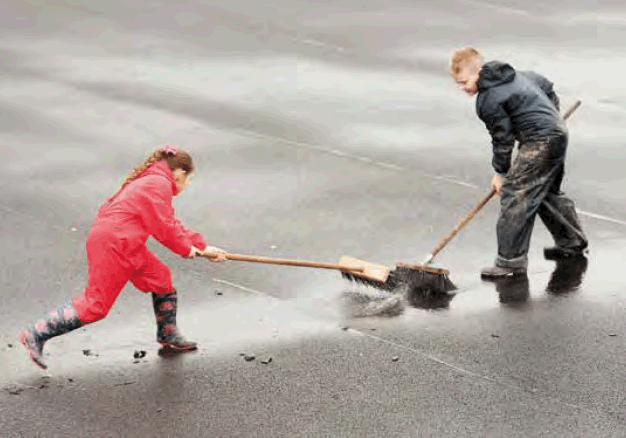
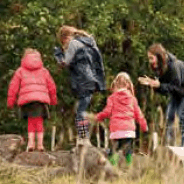
Section 2.6
Working with the school community
The school Parent Council, local tenants and residents association and other local groups are good points of contact to identify potential volunteers to help with the opening and closing of gates, if this has been identified as a potential approach.
Tools to assist
It is worth contacting the Community Council and other organisations in the area, including other departments of the local authority to identify what other play provision might be available locally and what support they might be able to offer.
Most Local Authorities in Scotland will have someone who is responsible for Play, but if not, there are regional play associations across Scotland. They can potentially help with advice about the range of play provision that can be developed and promoted using the existing grounds. They may be able to offer short-term staffed sessions to promote the opening of school grounds. Staffed play provision in particular may be able to provide advice on concerns over fears of damage and vandalism. They may also help to organise a play event in the school grounds to help promote playing and to answer questions that might arise.
Holding a community meeting is a good way to help parents and others to understand what the plans are for out of teaching hours use. Here, ideas can be shared and the space that will be available for children for their own free play can be discussed. It can be established that the space will be unsupervised and that the buildings will not be open.
Engaging with a Police Community Officer will ensure that it is well understood what the space is for. They will be keen to know of all the spaces in the community that children have permission to play and gather in and will also be keen to help protect that provision.
This may also provide a good opportunity to promote the importance of play to parents and the wider community and allay any fears they may have. This meeting will also provide an opportunity for the school to discuss the importance of play in school time with parents and the wider community.
Schools can use and adapt the Top tips for a playful community to help promote play locally and support parents.
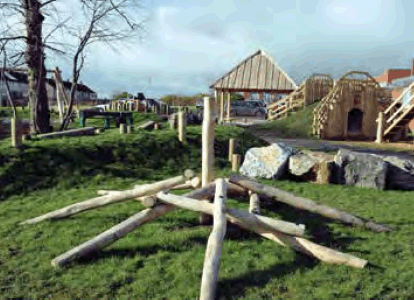
Top tips for a playful community
To encourage parents and carers and local communities to support children playing out confidently beyond any organised event, these top tips may help:
Prepare children to be road safe
Streets make up the major part of public space within communities. Children can be prepared from an early age by telling them and showing them ways to keep themselves safe on and around roads.
Look to everyone’s driving habits
Parents are often concerned about traffic when giving children permission to play out. As drivers, everyone can drive at safe speeds in the same way everyone would wish others to drive in the residential streets where children play.
Help children get to know their community
If adults and children are less reliant on travelling by car in their local communities, children will get to know their local streets. Walking to and from local facilities such as the shops, school and the park can help everyone identify solutions together with children to keep themselves safe.
Be community friendly
Everyone can get to know local people, neighbours and other families, and agree with each other to keep an eye out for children. This fosters a sense of a safe community, allowing more children to play out more, and to be safer doing so.
Trust children
Agreements can be made with children on where and how long they go out to play. If they know their local area, their address and phone number, and whom they can call on, and tell the time, it helps to make those arrangements.
Be realistic
Keeping everyone’s worries in perspective and knowing neighbours and local residents who can be called on for support and help if there are any concerns. The benefits of playing out far outweigh the risks.
Make a change
Everyone can campaign locally for changes to their community that may make local areas places where children can play out confidently. The importance of playing out can be shared within communities by word of mouth or holding community events and letting others know about them.
Community Agreement
When considering the options for the opening of schools grounds, it is likely that a number of individuals and groups will come together to plan the arrangements. A Memorandum of Understanding offers a way for sharing an understanding of what is proposed; to open outdoor facilities for community use. It doesn’t need to be a complicated document.
It is important to ensure that it is clear what each party or person is tasked with and who takes overall responsibility for critical elements such as insurance, maintenance and inspection.
“We’ve managed to open part of our grounds because we worked with an established Community Network. This group of people is both keen and used to taking on responsibilities. They have good community links, but also support staff which has helped maintain continuity”
Memorandum of understanding template
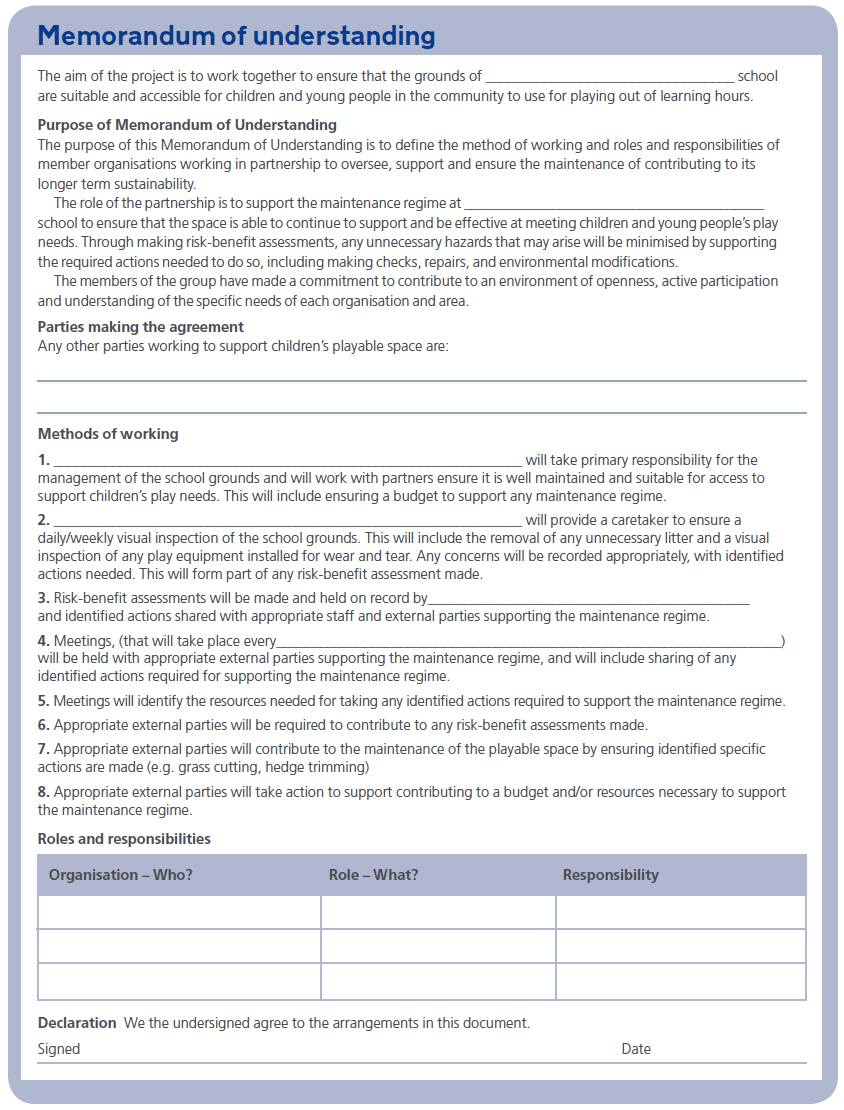
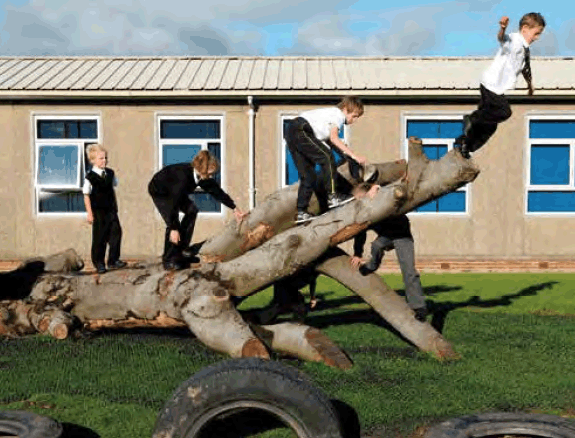
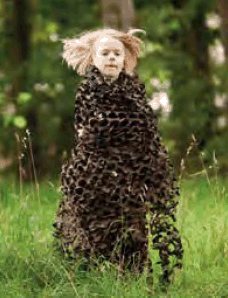
Section 2.7
Risk management
As part of responsibilities relating to inspection and maintenance of the play space, it is necessary to conduct regular operational risk-benefit assessments. It is likely this will be a condition of the insurance.
The primary purpose of a risk-benefit assessment is to show that any potential risks have been identified and control measures put in place to manage those risks.
Risk-benefit assessment
Risk-benefit assessment is an approach to risk management that also takes into account the benefit to the child of having access to a particular risk. This is a rational consideration in children’s play provision.
For example: the risks associated with a climbing frame are slips and falls from the equipment. There are controls that might be put in place to minimise the risks arising from falling.
However, before establishing controls, consideration should be given to why children should be allowed to climb to height. This is where benefits apply. Likely benefits include: building physical strength, balance and co-ordination; children learning to assess risks for themselves and experiencing feelings of excitement.
Building risk-benefit assessment into the risk management approach shows that all these factors have been considered, which increase the playability of the play space.
Risk management policy template
The Risk management policy template overleaf can be adapted to meet the needs of the school. The policy sets out the risk-benefit approach to managing risks and allows the inclusion of school procedures, frequency of inspections and routine maintenance programme. Having a risk management policy goes beyond requirements for conducting a risk assessment, to give a robust framework for how organisations manage risks over time and use the knowledge gained to update and improve operational (paper-based) risk assessments.
Risk management policy template
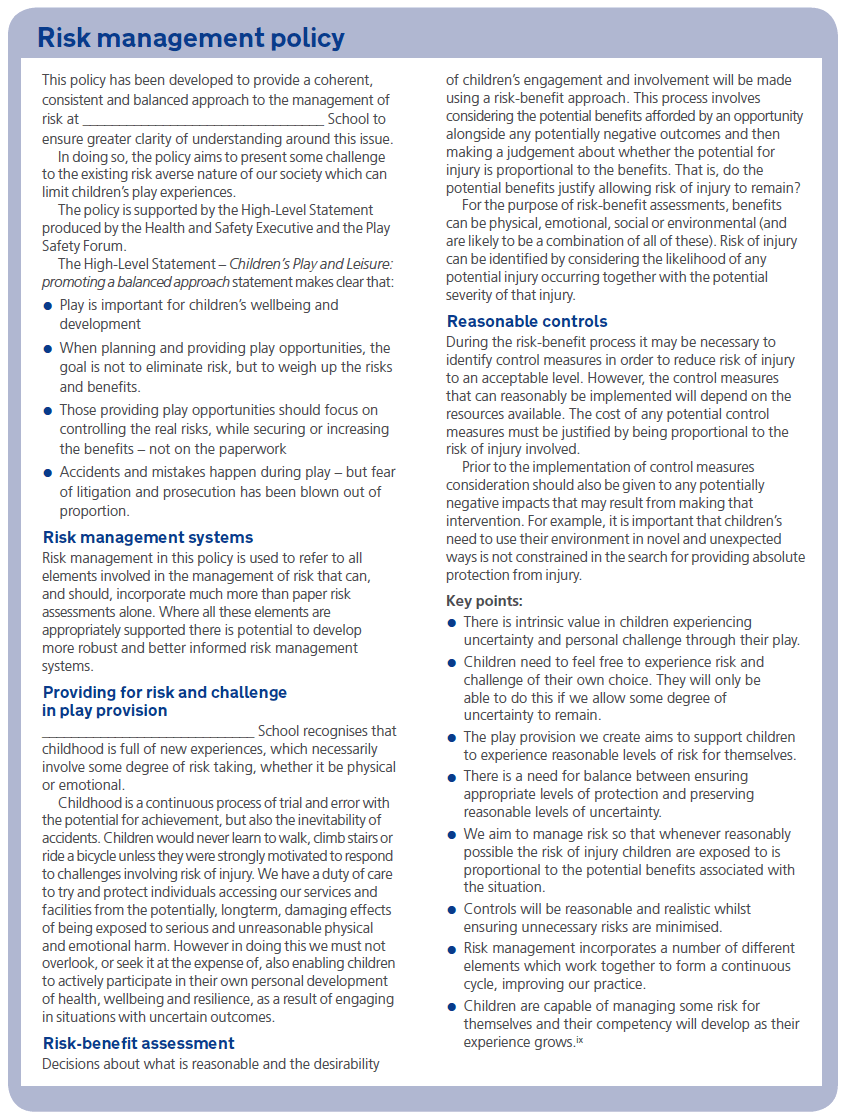
Section 2.8
Risk-benefit assessment
This risk-benefit assessment template/example is designed to include value-based risk benefit assessment as described in the Health and Safety Executive (HSE) endorsed Managing Risk in Play Provision: Implementation Guide.
The Play Forum worked example can be found at http://www.playboard.org/wp-content/uploads/2014/11/PSF-Risk-Benefit-Assessment-Form-Worked-Example.pdf
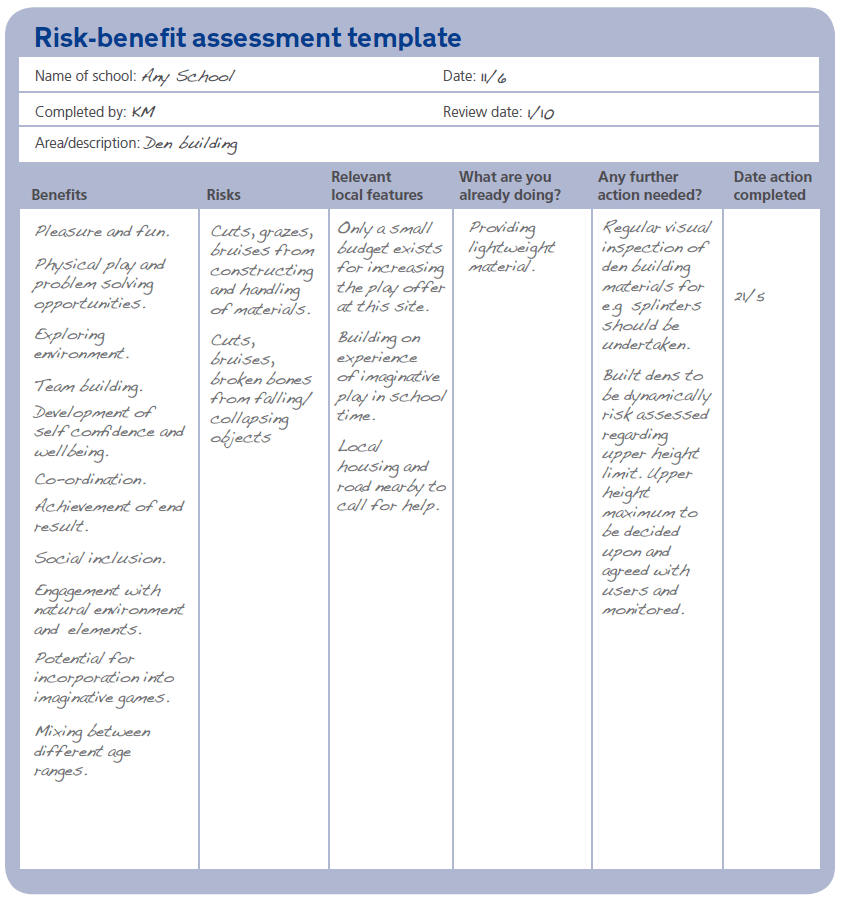
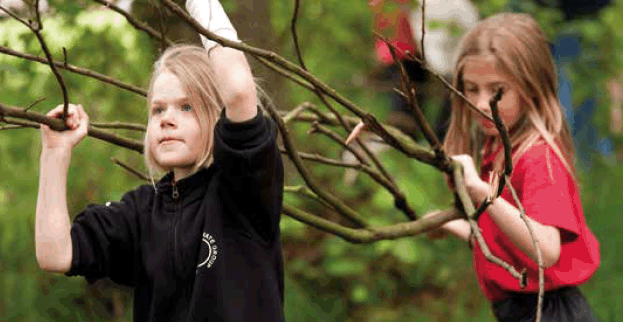
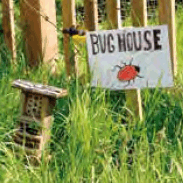
Section 2.9
Maintenance
A regular programme of maintenance will be required for the play space. How this is arranged will depend on the local situation and level of use.
Regular daily or weekly checks which are quick and easy to undertake will already be taking place. These checks involve checking for signs of deliberate misuse, vandalism and removing litter or dangerous items.
Maintenance considerations
Below are some factors to take into account in relation to maintenance.
- Can a local organisation who can take responsibility for maintenance be identified?
- What general maintenance will be required? Litter picking, mowing and general repairs can all be undertaken by the local community.
- What specialist maintenance will be required? Replacement of worn out parts on play equipment is best left to a specialist.
- How much are the maintenance plans going to cost? Once the budget has been allocated it will need to be built into fundraising activities.
Signage
Signage can play an important role in providing information to users for the purposes of reporting accidents and damage. Signage can include:
- Contact details to report damage or accidents. The sign can include the phone number or email address for the school.
- Pictogram ‘No Dogs’ and ‘No Smoking’ signs.
- Where there are overhead electric cables nearby ‘No Kite Flying’ signs are recommended.
Signage should also be welcoming and child-friendly. If possible work with pupils to design signage that reflects the community and the children who live there.
Routine play space checks template
As a guide if the school grounds usually score 1 or 2 they may only require weekly checks, if it’s 4 or 5, daily checks may be needed. We can use this tool to monitor levels of maintenance needed and also seasonal changes.
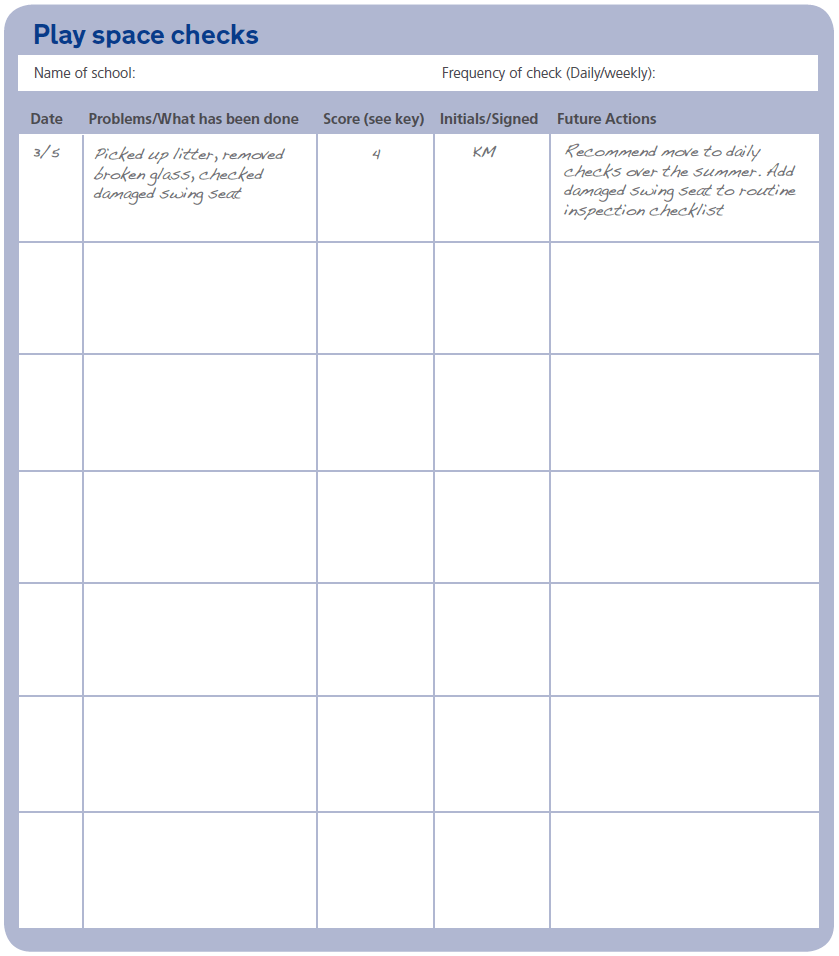
Key – (Scoring) Allocate a number of 1-5 to represent the level of damage/maintenance required at each visit.
1 = Little or no litter, no damage
2 = Some litter, signs of regular use and wear
3 = Moderate litter, some removal of dangerous objects
4 = Significant litter and/or damage
5 = Signs of very heavy use, lots of litter, dangerous objects to remove, significant regular maintenance needed
Contact
Email: Deborah Gallagher
There is a problem
Thanks for your feedback